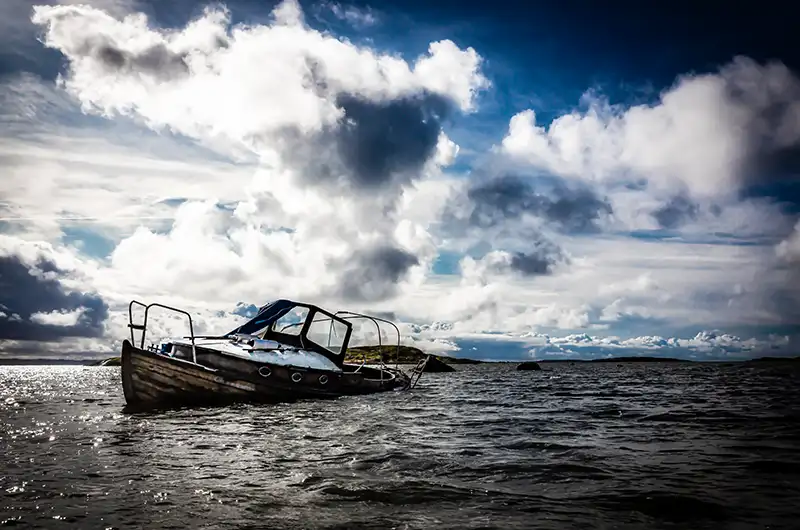
Few experiences are more disorienting and terrifying for a boater than your vessel overturning. While not a common occurrence, it can and does happen. When it does, it can happen quickly. You’re suddenly in the water, adrenaline pumping, and the first instinct can be to panic. However, if your boat capsizes and remains afloat, the key is to keep a clear head and take methodical steps.
Stay Calm and Assess the Situation
When your boat capsizes, it’s natural to feel a surge of fear. But keeping your composure and quickly evaluating your surroundings can make all the difference.
- Account for All Passengers: Call out names or headcounts to ensure nobody is missing. If you’re unsure whether someone is trapped under the boat, try to quickly scan the underwater portion if it’s safe to do so.
- Check for Injuries: Before anything else, make sure everyone in the water is okay. If someone is hurt, do what you can to provide immediate assistance. Keep the injured person afloat and as stable as possible until professional help arrives.
- Assess the Boat’s Position: A capsized boat that remains afloat can act as a flotation device and a beacon for rescuers. By staying near or on the overturned hull, you increase your visibility and your odds of being found quickly.
Immediate Actions to Take
Once you’ve taken a breath and assessed any injuries, shift your focus to the actions that will keep you and your passengers safe.
Stay with the Boat
Unless the boat is drifting toward a more dangerous situation—like strong currents, rapids, or breaking waves – the best move is to remain close by. It’s far easier for rescuers to spot an overturned vessel than individual swimmers in open water.
Put on a Life Jacket
If you weren’t already wearing a life jacket, locate one among any floating gear. Make sure everyone else does the same.
Retrieve Safety Equipment
Check to see if any emergency or floating equipment is within reach, never try to swim under an overturned boat.
- Flares or Signal Devices: Use them to signal passing boats or aircraft.
- Whistles or Air Horns: Sound carries well over water and can be critical for attracting attention.
- Coolers, Cushions, or Other Buoyant Items: Hang onto anything that helps keep you afloat and visible.
Signaling for Help
After you’ve established a safe position, your next concern is alerting potential rescuers.
- Use Visual Signals: If you have flares, use them when you see or hear a possible rescue vessel. In the absence of flares, use mirrors or bright clothing to reflect sunlight and catch attention.
- Whistle or Shout: Even if it feels futile, calling out periodically can be the difference between being heard by a passing boater and remaining undetected. A whistle is more effective and requires less energy than shouting.
- Activate an Emergency Beacon: If you have a Personal Locator Beacon (PLB) or a handheld VHF radio with DSC, engage it to send a distress signal. These devices can automatically transmit your position to rescue services.
- Stay Visible: If you’re in a group, stick together to form a larger object in the water. This makes it easier for rescuers to spot you, especially from above.
What to Do While Waiting for Rescue
If rescue isn’t immediate, your priority shifts to surviving the elements and conserving energy.
Conserve Energy
- Limit Movement in Cold Water: Moving too much accelerates heat loss.
- HELP (Heat Escape Lessening Posture): Tuck your legs and arms close to your body if you’re alone. If you have multiple people, huddle together to maintain warmth.
Stay Hydrated and Alert
- Avoid ingesting saltwater, as it can worsen dehydration.
- Stay on the lookout for nearby boats or debris that could assist in keeping you buoyant or sheltered.
Preventing Capsizing in the First Place
The best “solution” to a capsizing event is prevention. Follow these guidelines to significantly reduce your risk.
- Avoid Overloading: Every vessel has a maximum weight capacity. Overloading compromises stability, making you more susceptible to capsizing.
- Distribute Weight Properly: Keep heavier gear and passengers centered. If weight shifts too far to one side, the chance of tipping increases, especially in choppy conditions.
- Check Weather Conditions: Always review forecasts before heading out. Rough waves, strong currents, or sudden storms can challenge even the most experienced boater.
- Perform Regular Maintenance: A well-maintained hull and functioning bilge pump can keep your boat afloat. Check drain plugs before every outing and address any signs of damage promptly.
- Know Your Boat’s Stability Limits: Learn how your boat behaves in various sea conditions. Participate in practice drills to familiarize yourself and your passengers with emergency procedures.
- Ensure you deck hatches are closed and seal and bilge pumps are working. Most boats will capsize due to uncontrolled flooding and loss of stability.
Even the most prepared boater can run into an emergency. Sometimes it is not a matter of if, but when you may find yourself in this situation, so always be prepared.
